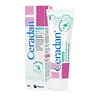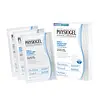What's inside
What's inside
 Key Ingredients
Key Ingredients

 Benefits
Benefits

 Concerns
Concerns

 Ingredients Side-by-side
Ingredients Side-by-side

Water
Skin ConditioningHydrogenated Polydecene
EmollientSimmondsia Chinensis Seed Oil
EmollientButylene Glycol
HumectantCyclopentasiloxane
EmollientGlycerin
HumectantBehenyl Alcohol
EmollientGlyceryl Stearate
EmollientPEG-60 Glyceryl Isostearate
Cetyl Alcohol
EmollientPentylene Glycol
Skin ConditioningTrideceth-12
EmulsifyingSodium Lauroyl Lactylate
EmulsifyingSorbitan Stearate
EmulsifyingBeeswax
Emulsion StabilisingDimethicone
EmollientPEG-32
HumectantPEG-6
HumectantHydroxypropyl Bispalmitamide Mea
EmollientPhenoxyethanol
PreservativeCarbomer
Emulsion StabilisingEthylhexylglycerin
Skin ConditioningCholesterol
EmollientLinoleic Acid
CleansingTocopherol
AntioxidantXanthan Gum
EmulsifyingSodium Hyaluronate
HumectantSodium Hydroxide
BufferingWater, Hydrogenated Polydecene, Simmondsia Chinensis Seed Oil, Butylene Glycol, Cyclopentasiloxane, Glycerin, Behenyl Alcohol, Glyceryl Stearate, PEG-60 Glyceryl Isostearate, Cetyl Alcohol, Pentylene Glycol, Trideceth-12, Sodium Lauroyl Lactylate, Sorbitan Stearate, Beeswax, Dimethicone, PEG-32, PEG-6, Hydroxypropyl Bispalmitamide Mea, Phenoxyethanol, Carbomer, Ethylhexylglycerin, Cholesterol, Linoleic Acid, Tocopherol, Xanthan Gum, Sodium Hyaluronate, Sodium Hydroxide
Water
Skin ConditioningMethylpropanediol
SolventGlycerin
Humectant1,2-Hexanediol
Skin ConditioningCetyl Ethylhexanoate
EmollientButylene Glycol
HumectantPanthenol
Skin ConditioningCaprylic/Capric Triglyceride
MaskingSqualane
EmollientBetaine
HumectantTrehalose
HumectantAllantoin
Skin ConditioningDipotassium Glycyrrhizate
HumectantLactobacillus Ferment
Skin ConditioningLactobacillus/Soybean Ferment Extract
Skin ConditioningSaccharomyces/Potato Extract Ferment Filtrate
HumectantSaccharomyces/Barley Seed Ferment Filtrate
HumectantCurcuma Longa Root Extract
MaskingMyristica Fragrans Extract
MaskingButyrospermum Parkii Butter
Skin ConditioningBeta-Glucan
Skin ConditioningCeramide NP
Skin ConditioningCholesterol
EmollientCetearyl Alcohol
EmollientBehenyl Alcohol
EmollientStearic Acid
CleansingSodium Polyacrylate
AbsorbentArachidyl Alcohol
EmollientArachidyl Glucoside
EmulsifyingHydrogenated Lecithin
EmulsifyingGlucose
HumectantPolymethylsilsesquioxane
Polyglyceryl-4 Caprate
EmulsifyingAcrylates/C10-30 Alkyl Acrylate Crosspolymer
Emulsion StabilisingXanthan Gum
EmulsifyingCarbomer
Emulsion StabilisingTrisodium EDTA
Tromethamine
BufferingWater, Methylpropanediol, Glycerin, 1,2-Hexanediol, Cetyl Ethylhexanoate, Butylene Glycol, Panthenol, Caprylic/Capric Triglyceride, Squalane, Betaine, Trehalose, Allantoin, Dipotassium Glycyrrhizate, Lactobacillus Ferment, Lactobacillus/Soybean Ferment Extract, Saccharomyces/Potato Extract Ferment Filtrate, Saccharomyces/Barley Seed Ferment Filtrate, Curcuma Longa Root Extract, Myristica Fragrans Extract, Butyrospermum Parkii Butter, Beta-Glucan, Ceramide NP, Cholesterol, Cetearyl Alcohol, Behenyl Alcohol, Stearic Acid, Sodium Polyacrylate, Arachidyl Alcohol, Arachidyl Glucoside, Hydrogenated Lecithin, Glucose, Polymethylsilsesquioxane, Polyglyceryl-4 Caprate, Acrylates/C10-30 Alkyl Acrylate Crosspolymer, Xanthan Gum, Carbomer, Trisodium EDTA, Tromethamine
Ingredients Explained
These ingredients are found in both products.
Ingredients higher up in an ingredient list are typically present in a larger amount.
Behenyl Alcohol is a type of fatty alcohol (these are different from the drying, solvent alcohols).
Fatty Alcohols have hydrating properties and are most often used as an emollient or to thicken a product. They are usually derived from natural fats and oils; behenyl alcohol is derived from the fats of vegetable oils.
Emollients help keep your skin soft and hydrated by creating a film that traps moisture in.
In 2000, Behenyl Alcohol was approved by the US as medicine to reduce the duration of cold sores.
Learn more about Behenyl AlcoholButylene Glycol (or BG) is used within cosmetic products for a few different reasons:
Overall, Butylene Glycol is a safe and well-rounded ingredient that works well with other ingredients.
Though this ingredient works well with most skin types, some people with sensitive skin may experience a reaction such as allergic rashes, closed comedones, or itchiness.
Learn more about Butylene GlycolCarbomer is a polymer of acrylic acid. Its main role is to create a gel consistency.
A high amount of carbomer can cause pilling or balling up of products. Don't worry, most products contain 1% or less of carbomer.
Cholesterol is a class of organic molecules called lipids. It helps hydrate your skin and is essential to having a healthy skin barrier.
Our skin naturally contains cholesterol in the outermost layer. Besides cholesterol, it also contains ceramides and fatty acids. Cholesterol makes up about 1/4 of your skin's outer layer and barrier. Your skin barrier is responsible for keeping allergens and microbes out. Having a healthy skin barrier is also responsible for keeping your skin firm and plump.
Our bodies use cholestrol to create vitamin D, steroid hormones, and more.
Learn more about CholesterolGlycerin is already naturally found in your skin. It helps moisturize and protect your skin.
A study from 2016 found glycerin to be more effective as a humectant than AHAs and hyaluronic acid.
As a humectant, it helps the skin stay hydrated by pulling moisture to your skin. The low molecular weight of glycerin allows it to pull moisture into the deeper layers of your skin.
Hydrated skin improves your skin barrier; Your skin barrier helps protect against irritants and bacteria.
Glycerin has also been found to have antimicrobial and antiviral properties. Due to these properties, glycerin is often used in wound and burn treatments.
In cosmetics, glycerin is usually derived from plants such as soybean or palm. However, it can also be sourced from animals, such as tallow or animal fat.
This ingredient is organic, colorless, odorless, and non-toxic.
Glycerin is the name for this ingredient in American English. British English uses Glycerol/Glycerine.
Learn more about GlycerinWater. It's the most common cosmetic ingredient of all. You'll usually see it at the top of ingredient lists, meaning that it makes up the largest part of the product.
So why is it so popular? Water most often acts as a solvent - this means that it helps dissolve other ingredients into the formulation.
You'll also recognize water as that liquid we all need to stay alive. If you see this, drink a glass of water. Stay hydrated!
Learn more about WaterXanthan gum is used as a stabilizer and thickener within cosmetic products. It helps give products a sticky, thick feeling - preventing them from being too runny.
On the technical side of things, xanthan gum is a polysaccharide - a combination consisting of multiple sugar molecules bonded together.
Xanthan gum is a pretty common and great ingredient. It is a natural, non-toxic, non-irritating ingredient that is also commonly used in food products.
Learn more about Xanthan Gum